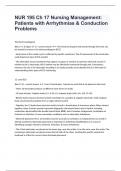NUR 195 Ch 17 Nursing Management:
Patients with Arrhythmias & Conduction
Problems
The Electrocardiogram
(Box 17-1 & Figure 17-1) - correct answer ✔✔- The electrical impulse that travels through the heart can
be viewed by means of an electrocardiogram (ECG)
- Each phase of the cardiac cycle is reflected by specific waveforms; The # & placement of the electrodes
used depend on type of ECG needed
- The electrodes record waveforms that appear on paper or monitor & represent electrical current in
relation to the 2 electrodes; HR & rhythm may be effectively monitored through only 2 electrodes;
however, the use of 10 electrodes (resulting in 12 leads) provides more detailed info & is the basis for
understanding other types of ECG monitoring
12- Lead ECG
(Box 17-2) - correct answer ✔✔- Uses 10 electrodes, 1 placed on each limb & six placed on the chest
- These 10 electrodes produce 12 different wave forms (or leads)
- 12 leads include: 3 bipolar leads (I, II, & III), & 9 unipolar leads (aVR, aVL, aVF, V1-V6)
- Bipolar leads measure electrical activity traveling b/w a positive & negative electrode, while unipolar
leads record electrical activity from a single reference point
- Together, the 12 leads show electrical activity in both a frontal plane & transverse plane; When viewed
together, these 2 planes provide important diagnostic info beyond heart rate & rhythm, including
conduction abnormalities like bundle branch block (BBB), heart chamber enlargement, localization of
ischemia or infarction, & even noncardiac conditions such as electrolyte imbalances
- Electrode placement for a 12-lead ECG must be accurate & consistent, as misplacement can result in
altered waveforms; Electrode placement is important in arrhythmia identification & is crucial in
identifying changes related to ischemia, infarction, & many arrhythmias
- The 4 limb electrodes are placed on the lower legs, near the ankles, & on the arms, near the wrists; The
remaining 6 electrodes are placed across the left side of the chest. Locating the specific anatomical
landmark is critical for correct chest electrode placement
, - If the pt needs a series of ECGs, consistency of electrode placement is also important. In some cases,
the chest electrodes are left in place or the correct location is marked w/ an indelible pen to ensure the
identical placement for follow-up ECGs
Placement of 12- Lead ECG - correct answer ✔✔- V1= right side of sternum, 4th intercostal space
- V2= left side of sternum, 4th intercostal space
- V3= midway b/w V2 & V4
- V4= mid-clavicular line, 5th inter coastal space
- V5= left anterior axillary line, same lvl as V4
- V6= left midaxillary line, same lvl as V4
** Precordial leads reflect electrical activity primarily in the left ventricle--other circumstances may
require alternate placement
Signs & Symptoms of Decreased Cardiac Output
(Table 17-1) - correct answer ✔✔- Respiratory: Tachypnea, SOB, orthopnea, dyspnea on exertion,
hypoxemia, crackles on lung auscultation, wheeze, dry or productive cough
- Cardiac & Peripheral Vascular: edema, JVD, displaced PMI, S3 gallop rhythm, tricuspid &/ or mitral
regurgitation murmurs, hypotension, decreased mean arterial pressure (MAP), narrow pulse pressure,
cool skin & extremities, delayed capillary refill, tachycardia
- Renal: decreased urinary output, oliguria, rising creatinine
- GI: abdominal distention, ascites, liver engorgement, positive abdominojugular reflex
- Central Nervous: dizziness, decreased sensorium, syncope, fatigue
- Behavioral/Emotional: Anxiety, restlessness
Interpreting The ECG
(Figure 17-3) - correct answer ✔✔- ECG waveforms are printed on graph paper that is divided by light &
dark vertical & horizontal lines at standard intervals; Time & rate are measured on horizontal axis of
graph, & amplitude or voltage is measured on vertical axis
- Each small block on the graph paper equals 0.04 second, & 5 small blocks form a large block, which
equals 0.2 second
- When an ECG waveform moves toward the top of the paper, it is called a positive deflection; When it
moves toward the bottom of the paper, it is called a negative deflection




